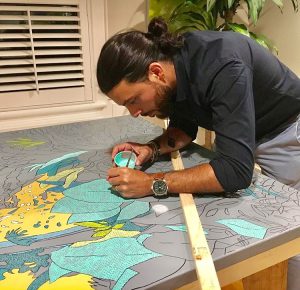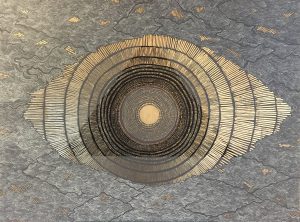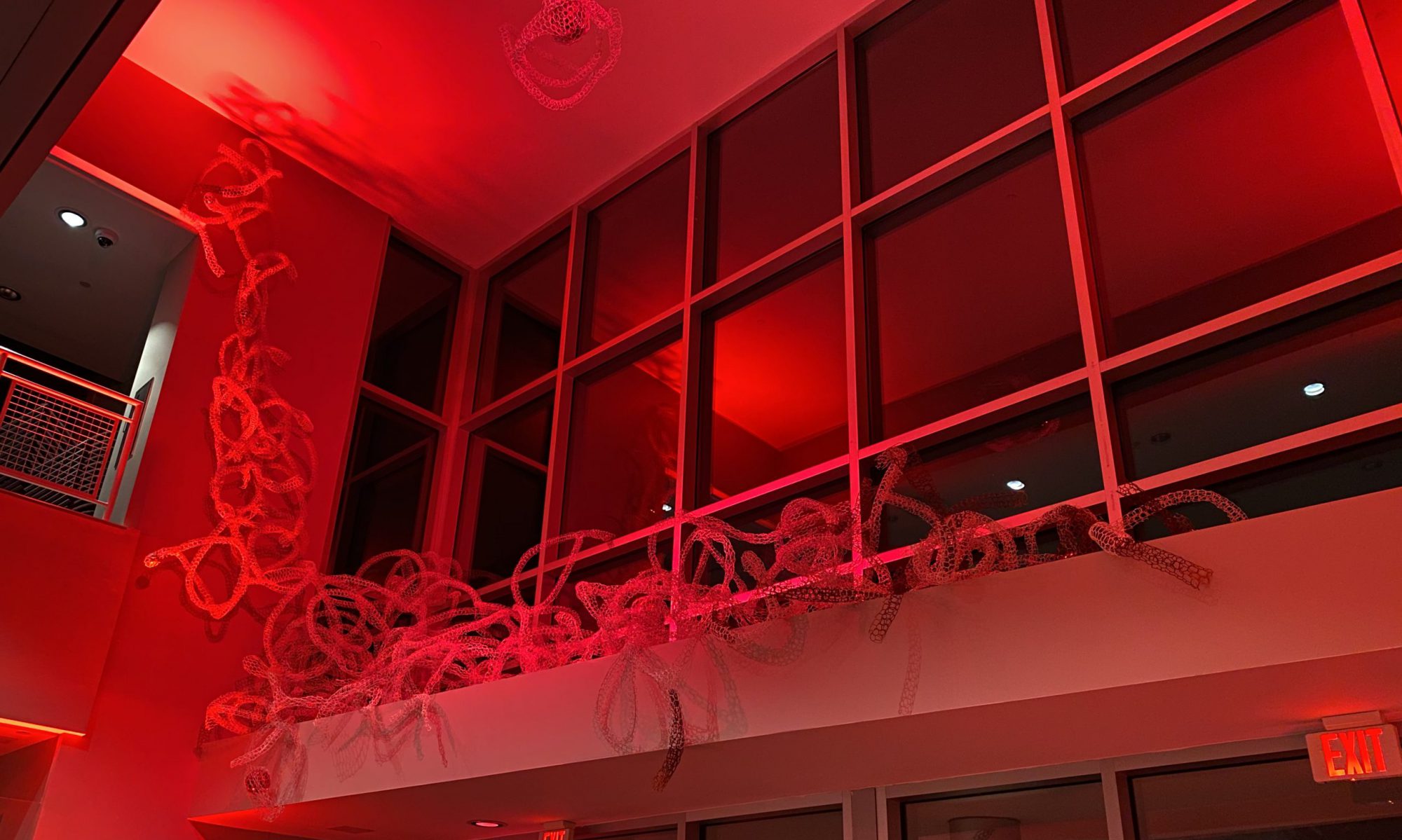Andrea Limauro
A Rising Tide Lifts All Boats
Forum Gallery
August 24, 2019 – October 6th, 2019
Exhibition Reception: September 7th, 2019 2-4PM
BIOGRAPHY
 ANDREA LIMAURO (b. Rome, Italy) is a visual artist and city planner, who holds a BA in Politics and Sociology from Essex University, UK, a Graduate Diploma in International Development from the University of Padua, Italy, and a Masters Degree in Urban Planning and Policy at the University of Illinois at Chicago. In his recent artwork, Limauro explores issues of migration and migrant identity, climate change, nationalistic narratives and gun violence.
ANDREA LIMAURO (b. Rome, Italy) is a visual artist and city planner, who holds a BA in Politics and Sociology from Essex University, UK, a Graduate Diploma in International Development from the University of Padua, Italy, and a Masters Degree in Urban Planning and Policy at the University of Illinois at Chicago. In his recent artwork, Limauro explores issues of migration and migrant identity, climate change, nationalistic narratives and gun violence.
Limauro’s work has been exhibited throughout the Washington, DC area including at the IA&A at Hillyer, WAS Gallery, Touchstone Gallery, the Annapolis Maritime Museum, and the Arlington Art Center. His paintings have been featured in the Washington Project for the Arts annual auctions (2016, 2017, 2018, 2019), online auctions on Paddle8, in art publications in the USA, UK, and Italy, and have been reviewed by the Washington Post and the Washington City Paper. Limauro serves as a Board Member of the non-profit art advocacy group Washington Project for the Arts. Currently, the artist resides in Silver Spring, Maryland.
ARTIST STATEMENT
My aestheticism is the means to my political and social agenda. I do not hide my positions, in fact, they dominate my art. I use beauty to lure viewers to engage with my work and my agenda.
 My art practice bridges my passion for creative and aesthetical exploration with my interests in history and politics, and my belief in the artist’s role as an agent of social change. Thus, my art practice is anchored in my belief that artists are political agents and that, given their ability to create objects and experiences that move and stir emotions in people, they have a social responsibility towards making socially meaningful creations that positively contribute to human progress.
My art practice bridges my passion for creative and aesthetical exploration with my interests in history and politics, and my belief in the artist’s role as an agent of social change. Thus, my art practice is anchored in my belief that artists are political agents and that, given their ability to create objects and experiences that move and stir emotions in people, they have a social responsibility towards making socially meaningful creations that positively contribute to human progress.
My inspiration is rooted in my life experiences growing up in public housing in Rome while being surrounded by art and ruins, growing up with a father-soldier shipped to global war-zones during my childhood, my own experience working in rural villages during the Angolan civil war, researching and interviewing child-soldiers in Sierra Leone, being a victim and a survivor of gun violence in the US, experiencing “serial migration”, becoming a father and working on climate change resilience.
Thus, it is not surprising that my work explores issues of migration and migrant identity, the fleeting concepts of home and safety, nationalistic narratives and gun violence in the US, and climate change.
“A Rising Tide Lifts All Boats” is both the name of this exhibition and the title of a 12-foot-wide quadriptych (four-part) painting originally commissioned by the NoMa Business Improvement District (BID).
The exhibition “A Rising Tide Lifts All Boats” combines two bodies of work that I have been working on since 2017: the “Mare Nostrvm” migration series and a newer emerging body of work around climate change.
“Mare Nostrvm” (Latin for “Our Sea”) takes the viewer through the odyssey of migration over the Mediterranean Sea – the deadliest migration route in the world.
Since the summer of 2014, Europe has been struck with its worst refugee crisis since the Second World War. Millions have fled their war-ravaged homelands in search of safety and a new “home,” causing political turmoil in a continent still recovering from economic recession(s). Of the thousands who have attempted to reach Europe, many have done so by crossing the Mediterranean Sea on small and overcrowded boats to reach the shores of Italy.
On the other hand, “A Rising Tide Lifts All Boats”, narrowly, is a dystopic artwork about the increased risk of flooding in Washington, D.C., due to climate change.

More broadly, however, it is also an allegory about the tragedy of human nature, which often is unwilling to make immediate sacrifices and lifestyle changes in order to guarantee shared gains, progress, and safety for ourselves and for future generations, unless catastrophe strikes.
A 360-degree, flattened panorama of a flooded Potomac riverfront in a not-too-farfetched future, “A Rising Tide Lifts All Boats” shows historic, cultural, political, military, and strategic infrastructure sites in the D.C. metro region at risk of flooding.
The selected sites have a history of flooding and are projected to be at even higher risk of flooding due to sea level rise and the more frequent and powerful weather events expected to hit our region in the near future.
As a reminder of how frequent and rooted in history flood events are, 12 dates are shown below the “Potomac River” inscription: these dates correspond with the largest Potomac River floods recorded as well as the earliest flooding event recorded, in 1748.
In fact, per historical accounts, as a young surveyor, George Washington was “blocked by flooding of the Potomac, which had been caused by the sudden runoff of snow melt high in the Appalachians” (Randall, 1998). The sites highlighted in the painting represent only a few of the significant areas most at risk of flooding and include, east to west, the City of Alexandria, Reagan National Airport, and the City of Arlington in Virginia; the National Mall and the monumental core, historic Fort McNair, Joint Base Anacostia-Bolling, and the Blue Plains Advanced Wastewater Treatment Plant (which serves the District of Columbia and several counties in Maryland and Virginia) in the District; and National Harbor in Maryland. For reasons of space and to avoid visual crowding, the artist does not include other at-risk sites such as the Georgetown waterfront, Foggy Bottom, Southwest DC, Buzzard Point, and Poplar Point.
Although the White House is only steps away from the flood plain, it is absent from the painting, to represent the current president’s choice of removing himself and the powers he holds from working toward a climate change solution. Instead, the president is leaving the disaster area in Air Force One, highlighting the chasm between people of power and means and the rest of the populace in surviving and adapting to disasters.
Finally, I have transplanted real photos of migrants in the Mediterranean Sea to the Potomac. This is done both to create an imaginary bridge between his current home in the nation’s capital and the events happening in his country of origin, as well as to highlight that poor people across the globe are most at risk of enduring the brunt of the negative impacts of climate change.
Finally, the two bodies of work can also reflect the “present” and the “future” where Europe’s tumultuous politics caused by mass migration is foreboding of what is to be expected globally with mass migrations due to increased floods, natural disasters and heat.
Follow Andrea on Instagram at @AndreaLimauro and visit his website at https://www.andrealimauro.com/
